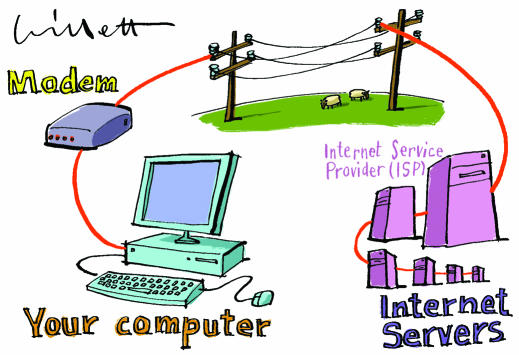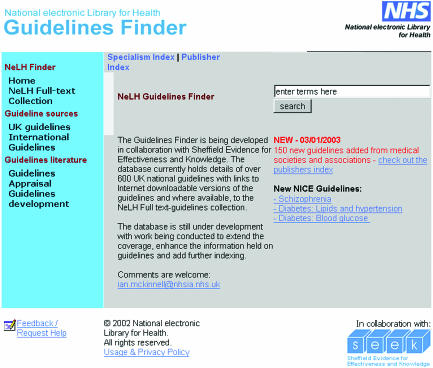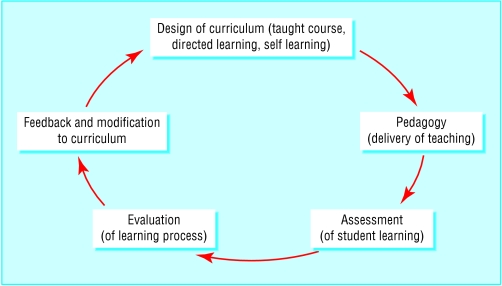Many of us use the internet or the “web” (world wide web) as a source of information. In medical education, the web is increasingly used both as a learning tool to support formal programmes and as a means of delivering online learning programmes. What can educators do to ensure that the potential of the web is used effectively to support both their own learning and that of their students? 
The technology
Much of the literature on web based learning shows that one of the main barriers to the effective use of teaching materials is the technology (for example, poor access, slow downloading) rather than the design of the learning materials themselves. Some of these issues are discussed later in the article, but it is vital that teachers take on expert help with technical issues in the planning, design, and delivery of web based learning programmes. Through programming and the use of “plug-ins” (programs that can be downloaded from the internet), designers can produce interactive course materials containing online activities (such as self assessments), animations, and simulations. These can improve learning and are often more enjoyable and meaningful for learners.
Glossary
E-conferencing—Use of online presentations and discussion forums (in real time or stored as downloadable files on a website) to avoid the need for participants to travel
E-learning—Learning through electronic means, such as via the web (see world wide web), an intranet, or other multimedia materials
HTML (hypertext markup language)—The language used to create web pages. HTML files can also contain links to other types of files including wordprocessed files, spreadsheets, presentation slides, and other web pages
Hyperlinks—Links in web pages that enable the user to access another web page (either on the same or a different site) with just one mouse click
Internet—A global network of computers divided into subsets (for example, the web or email systems). Computers are linked to the internet via host computers, which link to other computers via dial up (for example, via a modem) and network connections
Internet service provider (ISP)—Home users usually access the internet through an internet service provider (such as AOL), which maintains a network of PCs permanently connected to the internet
Intranet—A network of computers that share information, usually within an organisation. Access normally requires a password and is limited to a defined range of users
Managed learning environment (MLE)—Usually has an integrated function, providing administrative tools, such as student records, and linking with other management information systems (MLS)
Search engines (such as Lycos, Google)—Can be used to help to find information
Videostreaming—The process by which video images are able to be stored and downloaded on the web. These might be in real time (such as a conference) or used asynchronously
Virtual learning environment (VLE)—A set of electronic teaching and learning tools. Principal components include systems that can map a curriculum, track student activity, and provide online student support and electronic communication
World wide web (web)—Use of the internet to present various types of information. Websites or home pages may be accessed with the aid of a browser program (such as Netscape Communicator or Microsoft Explorer). All such programmes use HTML
For additional information see www.learnthenet.com/english/section/intbas.html
Distance learning
Two of the main developments in web based learning have been the adaptation of communication technology to support learning and the changes in distance learning strategies necessary for delivering online courses. Both aspects should be considered when designing or delivering web based learning programmes. Lessons can be learned by considering how distance education evolved.
Distance and open learning began with correspondence courses. The Open University in Britain is one of the best known examples of how university level education became accessible, through effective distance learning, to people who had neither the traditional qualifications nor the time to enter full time higher education.
The secret of the Open University's success lies in clearly identifying students' needs; providing effective, local support; and combining conventionally taught components with the use of up to date multimedia resources, including books, course guides, videotapes, audiotapes, television, e-conferencing, and discussion groups.
What is web based learning?
Web based learning is often called online learning or e-learning because it includes online course content. Discussion forums via email, videoconferencing, and live lectures (videostreaming) are all possible through the web. Web based courses may also provide static pages such as printed course materials.
One of the values of using the web to access course materials is that web pages may contain hyperlinks to other parts of the web, thus enabling access to a vast amount of web based information.
A “virtual” learning environment (VLE) or managed learning environment (MLE) is an all in one teaching and learning software package. A VLE typically combines functions such as discussion boards, chat rooms, online assessment, tracking of students' use of the web, and course administration. VLEs act as any other learning environment in that they distribute information to learners. VLEs can, for example, enable learners to collaborate on projects and share information. However, the focus of web based courses must always be on the learner—technology is not the issue, nor necessarily the answer.
“Newer technologies such as computers and video conferencing are not necessarily better (or worse) for teaching or learning than older technologies . . . they are just different . . . The choice of technology should be driven by the needs of the learners and the context in which we are working, not by its novelty.”Bates AW. Technology, open learning and distance education. London: Routledge, 1995
Models of web based learning
Several approaches can be used to develop and deliver web based learning. These can be viewed as a continuum. At one end is “pure” distance learning (in which course material, assessment, and support is all delivered online, with no face to face contact between students and teachers). At the other end is an organisational intranet, which replicates printed course materials online to support what is essentially a traditional face to face course. However, websites that are just repositories of knowledge, without links to learning, communication, and assessment activities, are not learner centred and cannot be considered true web based learning courses.
Features of a typical web based course
Course information, notice board, timetable
Curriculum map
Teaching materials such as slides, handouts, articles
Communication via email and discussion boards
Formative and summative assessments
Student management tools (records, statistics, student tracking)
Links to useful internal and external websites—for example, library, online databases, and journals
Learning and teaching support network (www.ltsn.ac.uk)
The learning and teaching support network (consisting of 24 subject centres) was set up to help staff in higher education to deliver programmes in their own subjects more effectively and to improve communication between teachers in different organisations and government agencies
One subject centre covers medicine, dentistry, and veterinary science (LTSN 01)
Although not strictly web based learning, LTSN 01 uses a combination of activities delivered via the web (such as an email discussion forum, copies of useful articles, research and funding programmes, and job vacancies) to support staff working in medical, dental, and veterinary education
In reality, most web based learning courses are a mixture of static and interactive materials, and most ensure that some individual face to face teaching for students is a key feature of the programme.
The individual learner
The first step in designing a web based course is to identify the learners' needs and whether the learners are to be considered as part of a group or as individual learners. The web can be a useful tool for bringing isolated learners together in “virtual” groups—for example, through a discussion forum. There are several online resources on how to design web based learning programmes (for example, at www.ltsn.ac.uk).
Questions to ask before starting a web based learning project
What is the educational purpose of the web based learning project?
What added value will online learning bring to the course or to the students?
What resources and expertise on web based learning exist in the institution?
Are colleagues and the institution aware of the planned course? (You need to avoid duplication of effort and be sure that the institution's computer system can support the course)
Has the project taken account of existing teaching resources and ongoing maintenance costs after initial development?
Have you allowed enough time to develop or redevelop materials?
Have the particular design and student support requirements of web based learning courses been taken into account? If not, the e-learning starter guides on the LTSN website are a good resource (www.ltsn.ac.uk/genericcentre)
Incorporating web based learning into conventional programmes
Web based learning in an institution is often integrated with conventional, face to face teaching. This is normally done via an intranet, which is usually “password protected” and accessible only to registered users. Thus it is possible to protect the intellectual property of online material and to support confidential exchange of communication between students.
Medicine has many examples of online learning, in both the basic sciences and clinical teaching. As students are usually in large groups for basic science teaching, web based learning can be used to provide learning materials to complement conventional programmes and to enable self assessment—for example, access to anatomical sites and image banks for the teaching of pathology courses. Web based learning can be useful to support clinical teaching when learners are geographically dispersed—for example, to learn clinical skills through video demonstrations.
With web based learning, the material can be linked to libraries (for example, for ordering books or journals), online databases, and electronic journals. These functions are particularly useful for research and clinical activities
Assessment
With all types of learning, including web based learning, it is useful for students to receive constructive, timely, and relevant feedback on their progress. Online assessment is sometimes constrained by the medium in which it is operating. Computer marked assessments alone are not appropriate for marking or giving feedback on assignments such as essays or projects that require more than the mere reproduction of knowledge.
Advantages and disadvantages of online assessment
Advantages
Students can receive quick feedback on their performance
Useful for self assessments—for example, multiple choice questions
A convenient way for students to submit assessment from remote sites
Computer marking is an efficient use of staff time
Disadvantages
Most online assessment is limited to objective questions
Security can be an issue
Difficult to authenticate students' work
Computer marked assessments tend to be knowledge based and measure surface learning
When planning online assessment it is important to determine what is to be assessed. If knowledge reproduction is being tested, objective questions (such as multiple choice or “true or false” questions) with instant or model answers can provide excellent feedback. Assessment of higher cognitive functions, such as analysis and synthesis, will require more complex tests. Automated marking may be difficult for such assessments, and the teacher is likely to have to do a substantial amount of work before he can add his or her comments to the student's record. Further guidance on how to design web based assessments for online courses can be found at www.ltsn.ac.uk and www.ltss.bris.ac.uk
Advantages and disadvantages of web based learning
Advantages
Ability to link resources in many different formats
Can be an efficient way of delivering course materials
Resources can be made available from any location and at any time
Potential for widening access—for example, to part time, mature, or work based students
Can encourage more independent and active learning
Can provide a useful source of supplementary materials to conventional programmes
Disadvantages
Access to appropriate computer equipment can be a problem for students
Learners find it frustrating if they cannot access graphics, images, and video clips because of poor equipment
The necessary infrastructure must be available and affordable
Information can vary in quality and accuracy, so guidance and signposting is needed
Students can feel isolated
For and against web based learning
When designing web based programmes (as with any learning programme), the learners' needs and experience must be taken into account. Appropriate technology and reasonable computer skills are needed to get the best out of web based or online learning. Programmes and web pages can be designed to accommodate different technical specifications and versions of software. It is frustrating for learners, however, if they are trying to work on the internet with slow access or cannot download images and videos they need. On the other hand, web based programmes may, for example, encourage more independent and active learning and are often an efficient means of delivering course materials. 
Effective web teaching and learning
Course designers need to remember that younger students are more likely to be familiar with using the internet than older learners, who may feel less comfortable with a web based course. To get the best out of their learning experience, learners need basic computer skills, support, and guidance.
Teachers must design their courses to encourage effective web based learning rather than aimless “surfing.” Programme design should therefore filter out poor information as well as signpost key information sources.
Many clinicians are beginning to use electronic patient records. This change means that doctors are becoming more adept at using computers and online resources to support their daily work and continuing professional development. Electronic media can facilitate access to evidence based resources such as the Cochrane Library. These web based clinical support sites are excellent resources for postgraduate “on the job” learning.
Further reading
Cook J. The role of virtual learning environments in UK medical education. LTSN Bioscience Bulletin 2002;5. http://bio.ltsn.ac.uk
Forsyth I. Teaching and learning materials and the internet. 3rd ed. London: Kogan Page, 2001.
Jolliffe A, Ritter J, Stevens D. The online learning handbook: developing and using web based learning. London: Kogan Page, 2001.
World Federation for Medical Education. www.sund.ku.dk/WFME/WFME%20Guidelines/guidelines99.html (paper on using information technology in education, including web based learning)
Teachers should be encouraged, through training and support, to use the web and other information technologysystems in their teaching. They need examples and awareness of good practice, and standards should be set in relation to how teachers present information and manage the learning environment.
Conclusion
Web based learning offers huge opportunities for learning and access to a vast amount of knowledge and information. The role of teachers is to ensure that the learning environment provided takes account of learners' needs and ensures that they are effectively prepared and supported. Online learning has advantages, but web based learning should not always be viewed as the method of choice because barriers (such as inadequate equipment) can easily detract from student learning. The technology must therefore be applied appropriately and not used simply because it is available and new or because students and teachers have particular expectations of this means of course delivery.
Figure.
The learning cycle: useful to bear in mind when planning a web based course
Footnotes
Judy McKimm is head of curriculum development at Imperial College School of Medicine, London, and an eduactional consultant; Carol Jollie is project officer in the skills enhancement project for the Camden Primary Care Trust at St Pancras Hospital, London.
The ABC of learning and teaching in medicine is edited by Peter Cantillon, senior lecturer in medical informatics and medical education, National University of Ireland, Galway, Republic of Ireland; Linda Hutchinson, director of education and workforce development and consultant paediatrician, University Hospital Lewisham; and Diana F Wood, deputy dean for education and consultant endocrinologist, Barts and the London, Queen Mary's School of Medicine and Dentistry, Queen Mary, University of London. The series will be published as a book in late spring.




